transmission fluid DODGE CHALLENGER 2014 3.G User Guide
[x] Cancel search | Manufacturer: DODGE, Model Year: 2014, Model line: CHALLENGER, Model: DODGE CHALLENGER 2014 3.GPages: 148, PDF Size: 3.71 MB
Page 3 of 148
INTRODUCTION/WELCOME
WELCOME FROM CHRYSLER GROUP LLC . . . 2
CONTROLS AT A GLANCE
DRIVER COCKPIT................4
INSTRUMENT CLUSTER ............6
GETTING STARTED
KEYFOB .....................8
REMOTE START.................9
KEYLESS ENTER-N-GO™ ...........10
VEHICLE SECURITY ALARM ..........13
SEATBELT ...................14
SUPPLEMENTAL RESTRAINT SYSTEM (SRS) —
AIRBAGS ....................15
CHILD RESTRAINTS ..............16
FRONT SEATS .................19
REARSEAT ...................21
HEATEDSEATS .................21
TILT/TELESCOPING STEERING COLUMN . . . 22
OPERATING YOUR VEHICLE
ENGINE BREAK-IN RECOMMENDATIONS . . . 23
TURN SIGNAL/WIPER/WASHER/HIGH BEAM
LEVER ......................24
HEADLIGHT SWITCH ..............25
SPEED CONTROL ................26
AUTOSTICK® ..................28
SPORT MODE – IF EQUIPPED .........29
MANUAL TRANSMISSION 1 TO 4 SKIP SHIFT . . 29AUTOMATIC TEMPERATURE CONTROLS
(ATC) ......................30
POWER SUNROOF...............31
WIND BUFFETING ...............33
ELECTRONICS
YOUR VEHICLE'S SOUND SYSTEM ......34
Uconnect® 130 .................36
Uconnect® 130 WITH SiriusXM SATELLITE
RADIO ......................38
Uconnect® 430/430N .............41
Uconnect® 730N ................50
SiriusXM SATELLITE RADIO/TRAVEL LINK . . 61
STEERING WHEEL AUDIO CONTROLS ....65
Uconnect® PHONE ...............65
Uconnect® VOICE COMMAND .........68
Bluetooth® STREAMING AUDIO ........71
iPod®/USB/MP3 CONTROL ..........71
ELECTRONIC VEHICLE INFORMATION CENTER
(EVIC) ......................72
PROGRAMMABLE FEATURES .........73
UNIVERSAL GARAGE DOOR OPENER
(HomeLink®) ..................75
POWER OUTLETS ...............77
UTILITY
TRAILER TOWING WEIGHTS (MAXIMUM TRAILER
WEIGHTRATINGS) ...............79
RECREATIONAL TOWING (BEHIND
MOTORHOME, ETC.) ..............79
SRT
AUTOSTICK®..................80ELECTRONIC CONTROL DAMPING SYSTEM . . . 81SRT PERFORMANCE FEATURES .......82
SUMMER/THREE-SEASON TIRES ......128
WHAT TO DO IN EMERGENCIES
ROADSIDE ASSISTANCE............84
INSTRUMENT CLUSTER WARNING LIGHTS . . 84
IF YOUR ENGINE OVERHEATS .........89
JACKING AND TIRE CHANGING ........90
BATTERY LOCATION ..............96
TIREFIT KIT ...................96
JUMP-STARTING ...............102
SHIFT LEVER OVERRIDE ...........104
TOWING A DISABLED VEHICLE .......105
FREEING A STUCK VEHICLE .........106
EVENT DATA RECORDER (EDR) ........107
MAINTAINING YOUR VEHICLE
OPENING THE HOOD.............108
ENGINE COMPARTMENT ...........109
FLUIDS AND CAPACITIES ...........112
MAINTENANCE SCHEDULE ..........116
FUSES .....................126
SUMMER/THREE-SEASON TIRES ......128
TIRE PRESSURES ...............129
WHEEL AND WHEEL TRIM CARE ......130
EXTERIOR BULBS ..............130
CONSUMER ASSISTANCE
CHRYSLER GROUP LLC CUSTOMER
CENTER....................131
CHRYSLER CANADA INC. CUSTOMER
CENTER ....................131
ASSISTANCE FOR THE HEARING
IMPAIRED ...................131
PUBLICATIONS ORDERING ..........131
REPORTING SAFETY DEFECTS IN THE
UNITEDSTATES ................132
MOPAR® ACCESSORIES
AUTHENTIC ACCESSORIES BY MOPAR® . . 133
FREQUENTLY ASKED QUESTIONS
FAQ’s ......................134
INDEX....................136
TABLE OF CONTENTS
Page 25 of 148
ENGINE BREAK-IN RECOMMENDATIONS
• A long break-in period is not required for the engine and drivetrain (transmission andaxle) in your vehicle.
• Drive moderately during the first 300 miles (500 km). After the initial 60 miles (100 km), speeds up to 50 or 55 mph (80 or 90 km/h) are desirable.
• While cruising, brief full-throttle acceleration within the limits of local traffic laws contributes to a good break-in. Wide-open throttle acceleration in low gear can be
detrimental and should be avoided.
• The engine oil installed in the engine at the factory is a high-quality energy conserving type lubricant. Oil changes should be consistent with anticipated climate conditions
under which vehicle operations will occur. For the recommended viscosity and quality
grades, refer to “Maintaining Your Vehicle.”
NOTE:
A new engine may consume some oil during its first few thousand miles (kilometers) of
operation. This should be considered a normal part of the break-in and not interpreted as an
indication of an engine problem or malfunction.
CAUTION!
Never use Non-Detergent Oil or Straight Mineral Oil in the engine or damage may result.
Engine Break-In Recommendation — SRT Version
A long break-in period is not required for the drivetrain (engine, transmission, and rear axle)
in your new vehicle.
Drive moderately during the first 500 miles (800 km). After the initial 60 miles (100 km),
speeds up to 50 or 55 mph (80 or 90 km/h) are desirable.
While cruising, brief full-throttle acceleration within the limits of local traffic laws contrib-
utes to a good break-in. However, wide-open throttle acceleration in low gear can be
detrimental and should be avoided.
The engine oil is a high performance synthetic lubricant, the transmission fluid, and axle
lubricant installed at the factory is high-quality and energy-conserving. Oil, fluid, and
lubricant changes should be consistent with anticipated climate and conditions under
which vehicle operations will occur. For the recommended viscosity and quality grades,
refer to “Maintaining Your Vehicle”.
NOTE:
A new engine may consume some oil during its first few thousand miles (kilometers) of
operation. This should be considered a normal part of the break-in and not interpreted as an
indication of difficulty.
CAUTION!
Never use Non-Detergent Oil or Straight Mineral Oil in the engine or damage may result.
OPERATING YOUR VEHICLE
23
Page 100 of 148
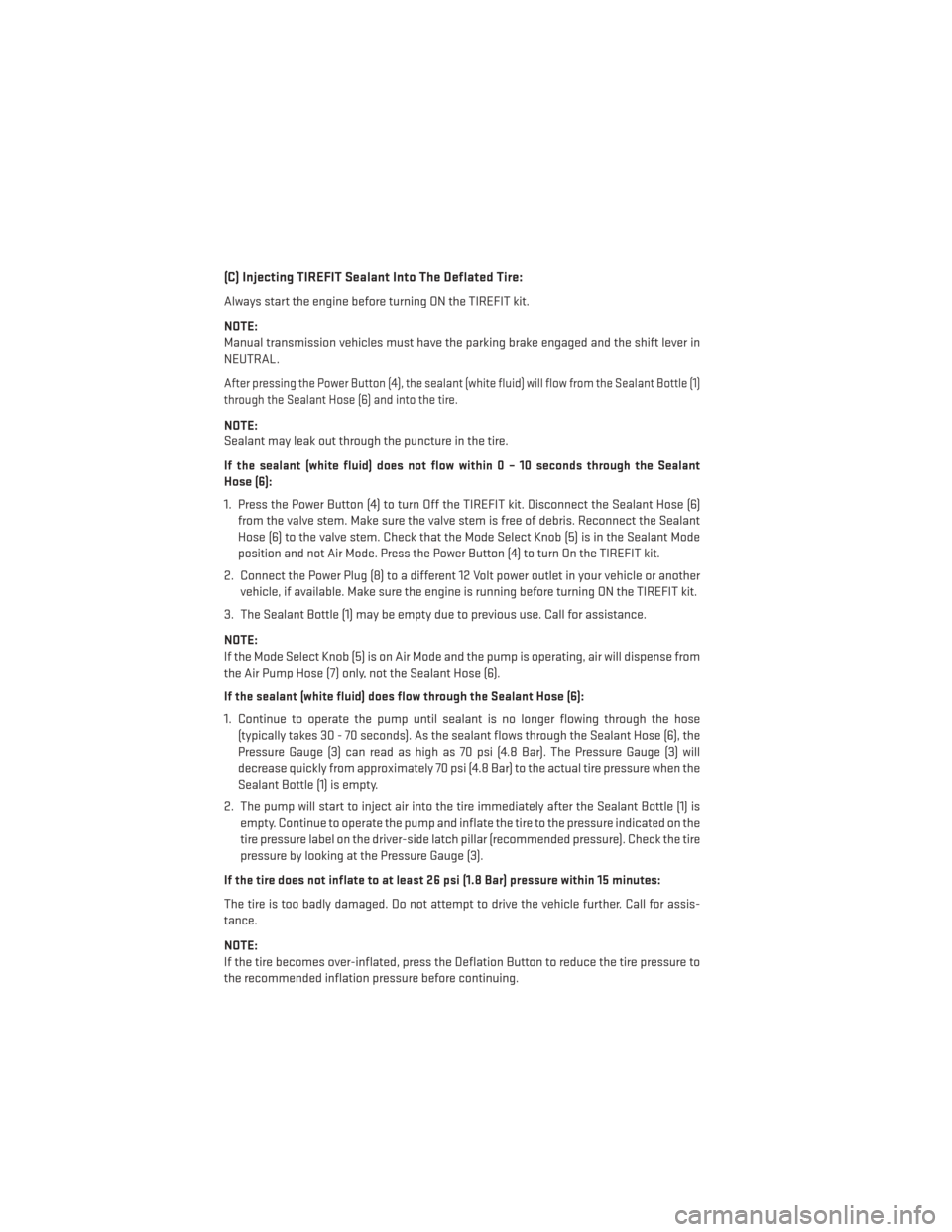
(C) Injecting TIREFIT Sealant Into The Deflated Tire:
Always start the engine before turning ON the TIREFIT kit.
NOTE:
Manual transmission vehicles must have the parking brake engaged and the shift lever in
NEUTRAL.
After pressing the Power Button (4), the sealant (white fluid) will flow from the Sealant Bottle (1)
through the Sealant Hose (6) and into the tire.
NOTE:
Sealant may leak out through the puncture in the tire.
If the sealant (white fluid) does not flow within0–10seconds through the Sealant
Hose (6):
1. Press the Power Button (4) to turn Off the TIREFIT kit. Disconnect the Sealant Hose (6) from the valve stem. Make sure the valve stem is free of debris. Reconnect the Sealant
Hose (6) to the valve stem. Check that the Mode Select Knob (5) is in the Sealant Mode
position and not Air Mode. Press the Power Button (4) to turn On the TIREFIT kit.
2. Connect the Power Plug (8) to a different 12 Volt power outlet in your vehicle or another vehicle, if available. Make sure the engine is running before turning ON the TIREFIT kit.
3. The Sealant Bottle (1) may be empty due to previous use. Call for assistance.
NOTE:
If the Mode Select Knob (5) is on Air Mode and the pump is operating, air will dispense from
the Air Pump Hose (7) only, not the Sealant Hose (6).
If the sealant (white fluid) does flow through the Sealant Hose (6):
1. Continue to operate the pump until sealant is no longer flowing through the hose (typically takes 30 - 70 seconds). As the sealant flows through the Sealant Hose (6), the
Pressure Gauge (3) can read as high as 70 psi (4.8 Bar). The Pressure Gauge (3) will
decrease quickly from approximately 70 psi (4.8 Bar) to the actual tire pressure when the
Sealant Bottle (1) is empty.
2. The pump will start to inject air into the tire immediately after the Sealant Bottle (1) is empty. Continue to operate the pump and inflate the tire to the pressure indicated on the
tire pressure label on the driver-side latch pillar (recommended pressure). Check the tire
pressure by looking at the Pressure Gauge (3).
If the tire does not inflate to at least 26 psi (1.8 Bar) pressure within 15 minutes:
The tire is too badly damaged. Do not attempt to drive the vehicle further. Call for assis-
tance.
NOTE:
If the tire becomes over-inflated, press the Deflation Button to reduce the tire pressure to
the recommended inflation pressure before continuing.
WHAT TO DO IN EMERGENCIES
98
Page 114 of 148
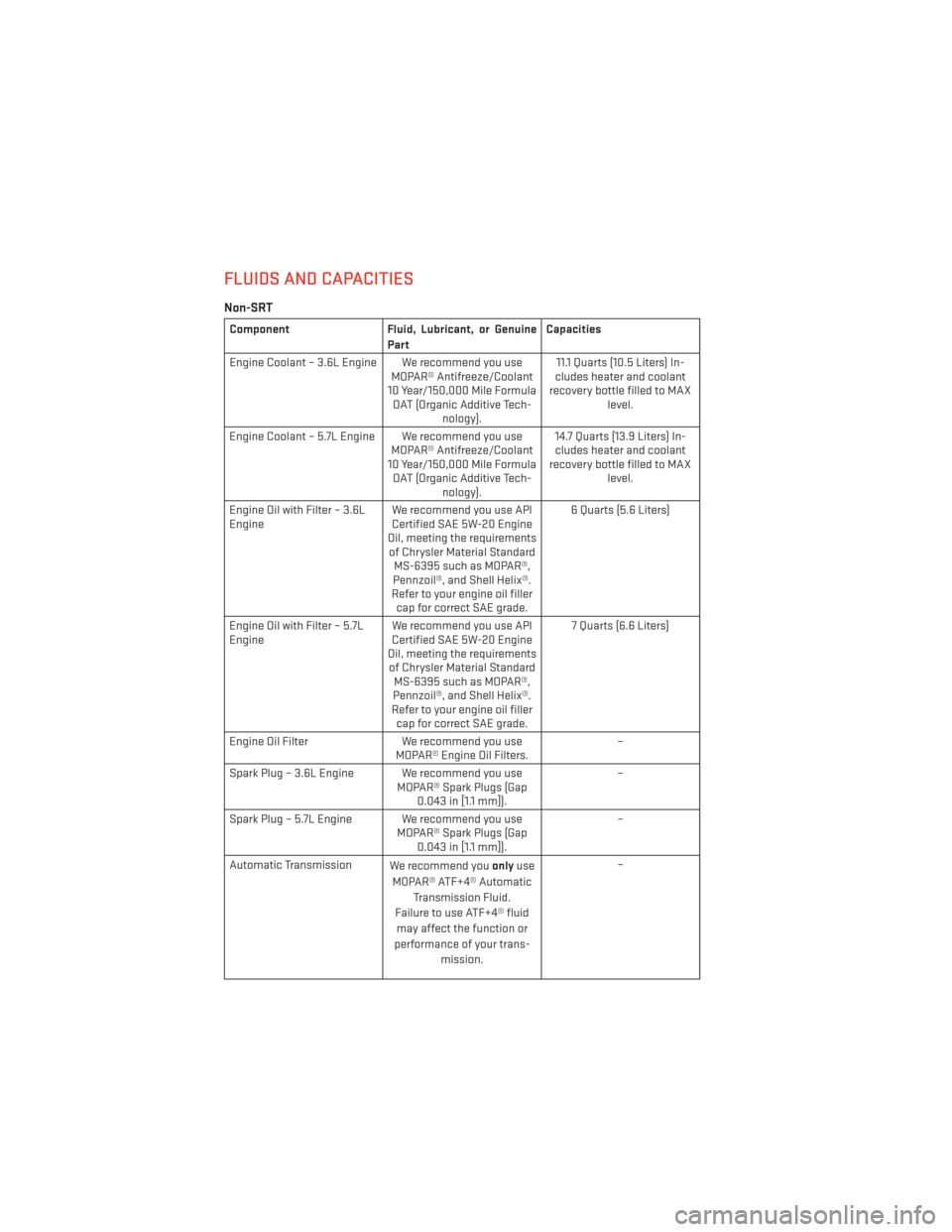
FLUIDS AND CAPACITIES
Non-SRT
ComponentFluid, Lubricant, or Genuine
Part Capacities
Engine Coolant – 3.6L Engine We recommend you use MOPAR® Antifreeze/Coolant
10 Year/150,000 Mile Formula OAT (Organic Additive Tech- nology). 11.1 Quarts (10.5 Liters) In-
cludes heater and coolant
recovery bottle filled to MAX level.
Engine Coolant – 5.7L Engine We recommend you use MOPAR® Antifreeze/Coolant
10 Year/150,000 Mile Formula OAT (Organic Additive Tech- nology). 14.7 Quarts (13.9 Liters) In-
cludes heater and coolant
recovery bottle filled to MAX level.
Engine Oil with Filter – 3.6L
Engine We recommend you use API
Certified SAE 5W-20 Engine
Oil, meeting the requirements of Chrysler Material Standard MS-6395 such as MOPAR®,
Pennzoil®, and Shell Helix®.
Refer to your engine oil filler cap for correct SAE grade. 6 Quarts (5.6 Liters)
Engine Oil with Filter – 5.7L
Engine We recommend you use API
Certified SAE 5W-20 Engine
Oil, meeting the requirements of Chrysler Material Standard MS-6395 such as MOPAR®,
Pennzoil®, and Shell Helix®.
Refer to your engine oil filler cap for correct SAE grade. 7 Quarts (6.6 Liters)
Engine Oil Filter We recommend you use
MOPAR® Engine Oil Filters. –
Spark Plug – 3.6L Engine We recommend you use MOPAR® Spark Plugs (Gap0.043 in [1.1 mm]). –
Spark Plug – 5.7L Engine We recommend you use MOPAR® Spark Plugs (Gap0.043 in [1.1 mm]). –
Automatic Transmission We recommend youonlyuse
MOPAR® ATF+4® Automatic Transmission Fluid.
Failure to use ATF+4® fluid may affect the function or
performance of your trans- mission. –
MAINTAINING YOUR VEHICLE
112
Page 115 of 148
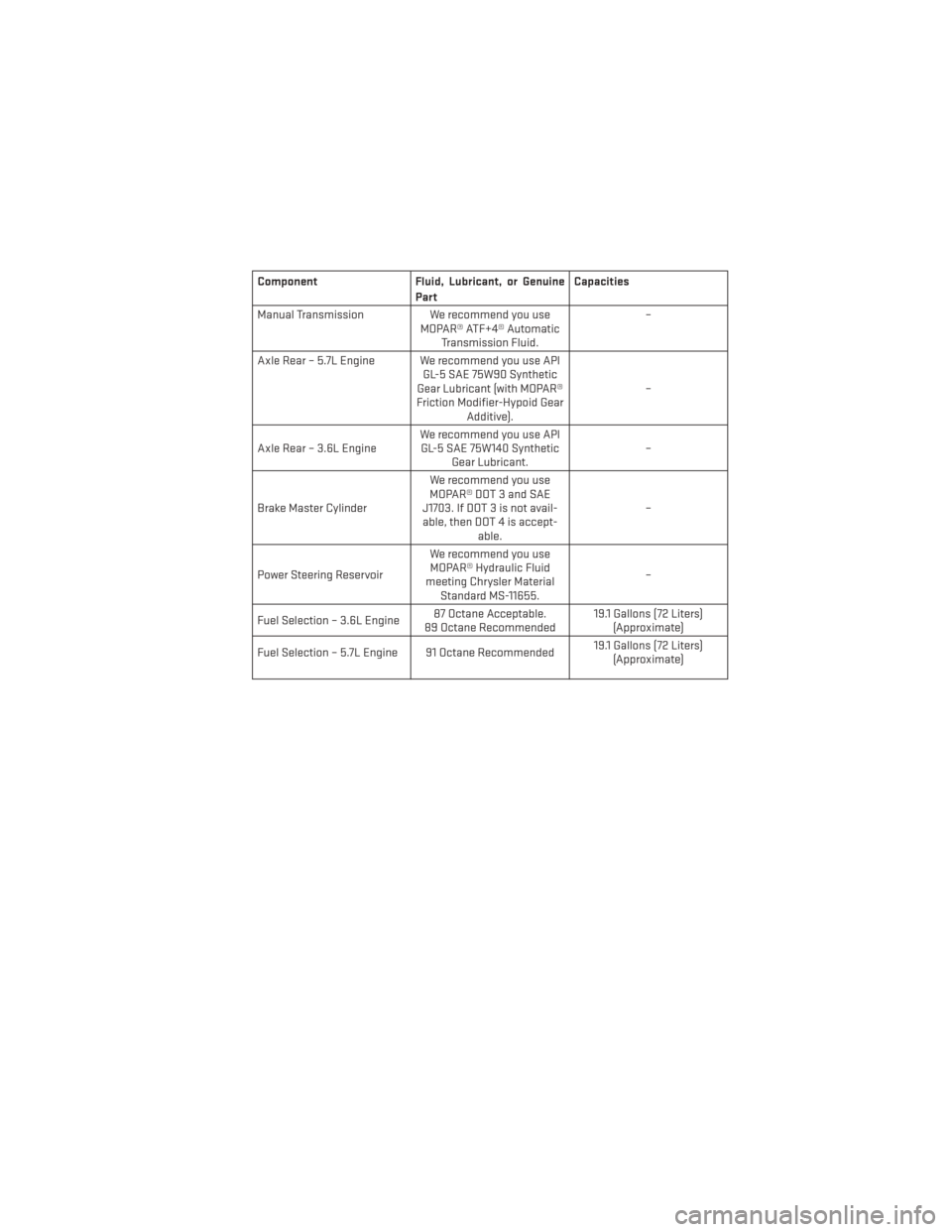
ComponentFluid, Lubricant, or Genuine
Part Capacities
Manual Transmission We recommend you use
MOPAR® ATF+4® Automatic Transmission Fluid. –
Axle Rear – 5.7L Engine We recommend you use API GL-5 SAE 75W90 Synthetic
Gear Lubricant (with MOPAR®
Friction Modifier-Hypoid Gear Additive). –
Axle Rear – 3.6L Engine We recommend you use API
GL-5 SAE 75W140 Synthetic Gear Lubricant. –
Brake Master Cylinder We recommend you use
MOPAR® DOT 3 and SAE
J1703. If DOT 3 is not avail- able, then DOT 4 is accept- able. –
Power Steering Reservoir We recommend you use
MOPAR® Hydraulic Fluid
meeting Chrysler Material Standard MS-11655. –
Fuel Selection – 3.6L Engine 87 Octane Acceptable.
89 Octane Recommended 19.1 Gallons (72 Liters)
(Approximate)
Fuel Selection – 5.7L Engine 91 Octane Recommended 19.1 Gallons (72 Liters)
(Approximate)
MAINTAINING YOUR VEHICLE
113
Page 116 of 148
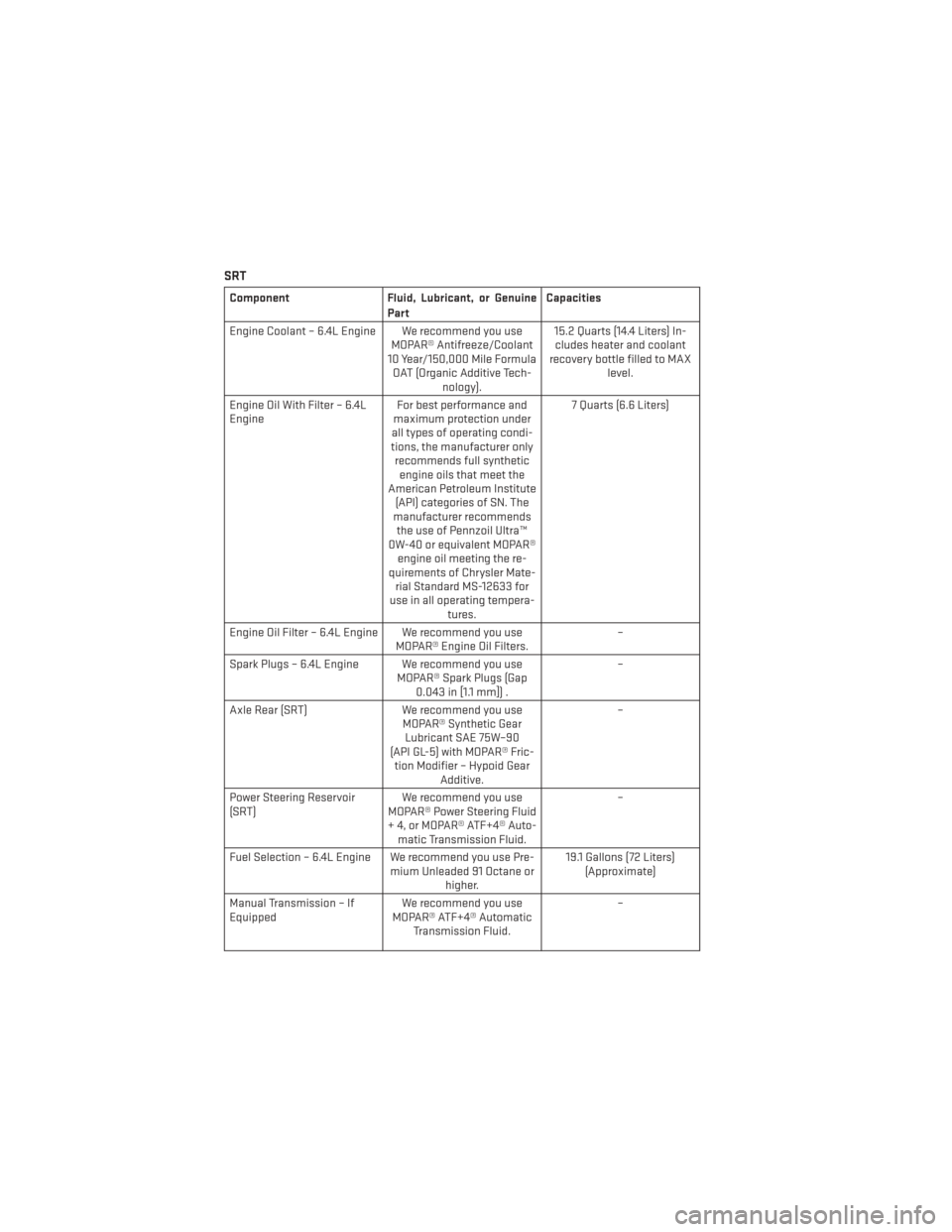
SRT
ComponentFluid, Lubricant, or Genuine
Part Capacities
Engine Coolant – 6.4L Engine We recommend you use MOPAR® Antifreeze/Coolant
10 Year/150,000 Mile Formula OAT (Organic Additive Tech- nology). 15.2 Quarts (14.4 Liters) In-
cludes heater and coolant
recovery bottle filled to MAX level.
Engine Oil With Filter – 6.4L
Engine For best performance and
maximum protection under
all types of operating condi-
tions, the manufacturer only recommends full synthetic engine oils that meet the
American Petroleum Institute (API) categories of SN. The
manufacturer recommends the use of Pennzoil Ultra™
0W-40 or equivalent MOPAR® engine oil meeting the re-
quirements of Chrysler Mate- rial Standard MS-12633 for
use in all operating tempera- tures. 7 Quarts (6.6 Liters)
Engine Oil Filter – 6.4L Engine We recommend you use MOPAR® Engine Oil Filters. –
Spark Plugs – 6.4L Engine We recommend you use MOPAR® Spark Plugs (Gap0.043 in [1.1 mm]) . –
Axle Rear (SRT) We recommend you use
MOPAR® Synthetic Gear Lubricant SAE 75W–90
(API GL-5) with MOPAR® Fric- tion Modifier – Hypoid Gear Additive. –
Power Steering Reservoir
(SRT) We recommend you use
MOPAR® Power Steering Fluid
+ 4, or MOPAR® ATF+4® Auto- matic Transmission Fluid. –
Fuel Selection – 6.4L Engine We recommend you use Pre- mium Unleaded 91 Octane orhigher. 19.1 Gallons (72 Liters)
(Approximate)
Manual Transmission – If
Equipped We recommend you use
MOPAR® ATF+4® Automatic Transmission Fluid. –
MAINTAINING YOUR VEHICLE
114
Page 117 of 148

ComponentFluid, Lubricant, or Genuine
Part Capacities
Automatic Transmission – If
Equipped We recommend you
onlyuse
MOPAR® ATF+4® Automatic Transmission Fluid.
Failure to use ATF+4® fluid may affect the function or
performance of your trans- mission. –
Brake Master Cylinder We recommend you use
MOPAR® DOT 3, SAE J1703. If DOT 3, SAE J1703 brake fluid
is not available, then DOT 4 is acceptable. –
CAUTION!
• Mixing of engine coolant (antifreeze) other than specified Organic Additive Technol-
ogy (OAT) engine coolant (antifreeze), may result in engine damage and may de-
crease corrosion protection. Organic Additive Technology (OAT) engine coolant is
different and should not be mixed with Hybrid Organic Additive Technology (HOAT)
engine coolant (antifreeze) or any “globally compatible” coolant (antifreeze). If a
non-OAT engine coolant (antifreeze) is introduced into the cooling system in an
emergency, the cooling system will need to be drained, flushed, and refilled with
fresh OAT coolant (conforming to MS-12106), by an authorized dealer as soon as
possible.
• Do not use water alone or alcohol-based engine coolant (antifreeze) products. Do not
use additional rust inhibitors or antirust products, as they may not be compatible
with the radiator engine coolant and may plug the radiator.
• This vehicle has not been designed for use with propylene glycol-based engine
coolant (antifreeze). Use of propylene glycol-based engine coolant (antifreeze) is not
recommended.
E-85 FLEXIBLE FUEL — (3.6L ENGINE ONLY)
Refer to your Owner's Manual on the DVD for further details.
CAUTION!
Only vehicles with the E-85 fuel filler door label or a yellow gas cap can operate on E-85.
MAINTAINING YOUR VEHICLE
115
Page 120 of 148
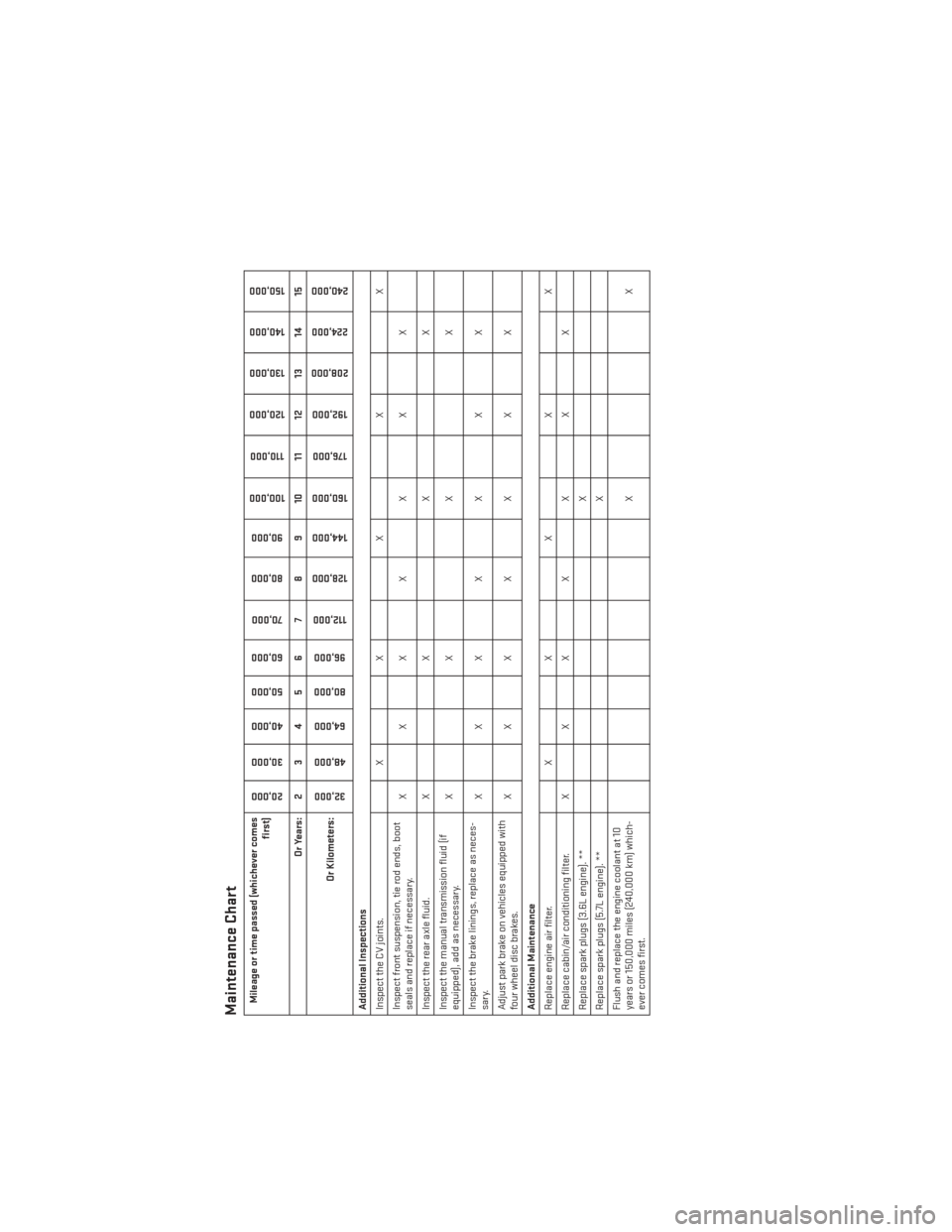
Maintenance ChartMileage or time passed (whichever comesfirst)
20,000
30,000
40,000
50,000
60,000
70,000
80,000 90,000
100,000
110,000
120,000 130,000
140,000
150,000
Or Years: 2 3 4 5 6 7 8 9 10 11 12 13 14 15
Or Kilometers:
32,000
48,000
64,000
80,000
96,000
112,000
128,000 144,000
160,000
176,000
192,000
208,000 224,000
240,000
Additional Inspections
Inspect the CV joints. X X X X X
Inspect front suspension, tie rod ends, boot
seals and replace if necessary. XXX X X X X
Inspect the rear axle fluid. X X X X
Inspect the manual transmission fluid (if
equipped), add as necessary. XX X X
Inspect the brake linings, replace as neces-
sary. XXX X X X X
Adjust park brake on vehicles equipped with
four wheel disc brakes. XXX X X X X
Additional Maintenance
Replace engine air filter. XX X XX
Replace cabin/air conditioning filter. X XX X X XX
Replace spark plugs (3.6L engine). ** X
Replace spark plugs (5.7L engine). ** X
Flush and replace the engine coolant at 10
years or 150,000 miles (240,000 km) which-
ever comes first. XX
MAINTAINING YOUR VEHICLE
118
Page 121 of 148
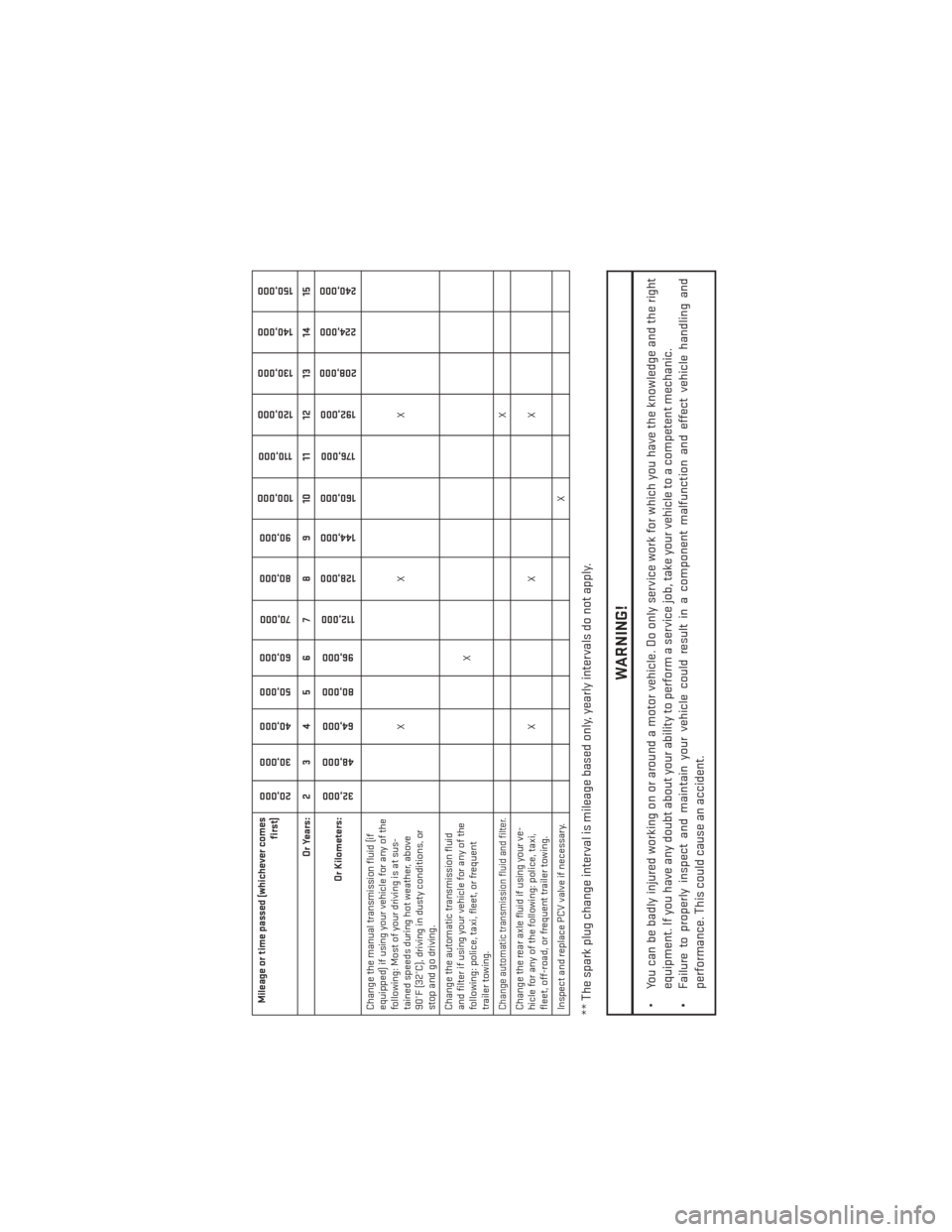
Mileage or time passed (whichever comesfirst)
20,000
30,000
40,000
50,000
60,000
70,000
80,000 90,000
100,000
110,000
120,000 130,000
140,000
150,000
Or Years: 2 3 4 5 6 7 8 9 10 11 12 13 14 15
Or Kilometers:
32,000
48,000
64,000
80,000
96,000
112,000
128,000 144,000
160,000
176,000
192,000
208,000 224,000
240,000
Change the manual transmission fluid (if
equipped) if using your vehicle for any of the
following: Most of your driving is at sus-
tained speeds during hot weather, above
90°F (32°C), driving in dusty conditions, or
stop and go driving. XX X
Change the automatic transmission fluid
and filter if using your vehicle for any of the
following: police, taxi, fleet, or frequent
trailer towing. XChange automatic transmission fluid and filter.
X
Change the rear axle fluid if using your ve-
hicle for any of the following: police, taxi,
fleet, off-road, or frequent trailer towing. XX X
Inspect and replace PCV valve if necessary. X
** The spark plug change interval is mileage based only, yearly intervals do not apply.
WARNING!
• You can be badly injured working on or around a motor vehicle. Do only service work for which you have the knowledge and the right equipment. If you have any doubt about your ability to perform a service job, take your vehicle to a competent mechanic.
• Failure to properly inspect and maintain your vehicle could result in a component malfunction and effect vehicle handling and
performance. This could cause an accident.
MAINTAINING YOUR VEHICLE
119
Page 125 of 148
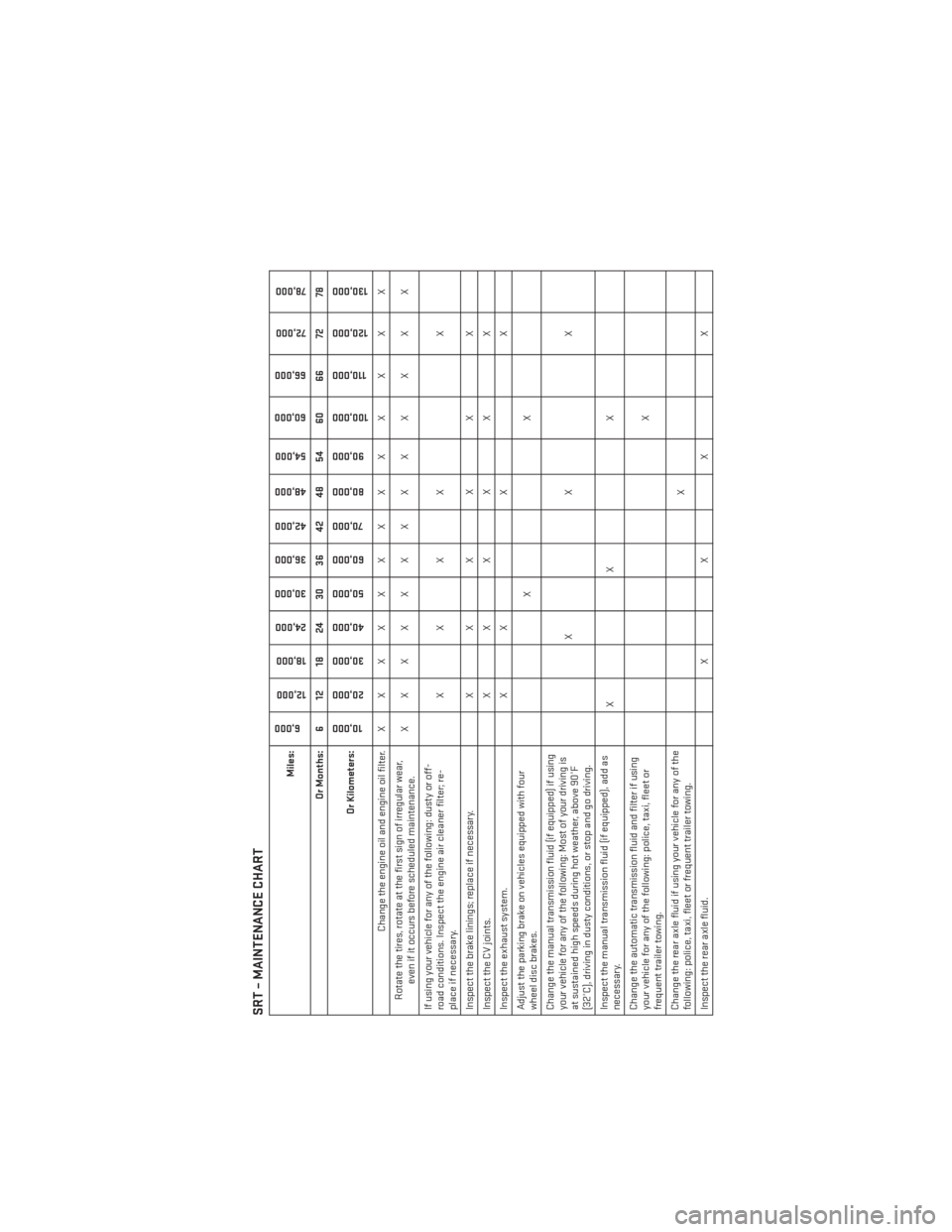
SRT – MAINTENANCE CHART
Miles:
6,000
12,000
18,000
24,000
30,000
36,000
42,000
48,000
54,000
60,000
66,000
72,000
78,000
Or Months: 6 12 18 24 30 36 42 48 54 60 66 72 78
Or Kilometers:
10,000
20,000 30,000
40,000
50,000
60,000 70,000
80,000
90,000
100,000
110,000
120,000 130,000
Change the engine oil and engine oil filter. XXXXXXX X X X X X X
Rotate the tires, rotate at the first sign of irregular wear, even if it occurs before scheduled maintenance. XXXXXXX X X X X X X
If using your vehicle for any of the following: dusty or off-
road conditions. Inspect the engine air cleaner filter; re-
place if necessary. XXX X
X
Inspect the brake linings; replace if necessary. XXX X X X
Inspect the CV joints. XXX X X X
Inspect the exhaust system. XX X X
Adjust the parking brake on vehicles equipped with four
wheel disc brakes. XX
Change the manual transmission fluid (if equipped) if using
your vehicle for any of the following: Most of your driving is
at sustained high speeds during hot weather, above 90°F
(32°C), driving in dusty conditions, or stop and go driving. XX X
Inspect the manual transmission fluid (if equipped), add as
necessary. XX X
Change the automatic transmission fluid and filter if using
your vehicle for any of the following: police, taxi, fleet or
frequent trailer towing. X
Change the rear axle fluid if using your vehicle for any of the
following: police, taxi, fleet or frequent trailer towing. X
Inspect the rear axle fluid. XX X X
MAINTAINING YOUR VEHICLE
123